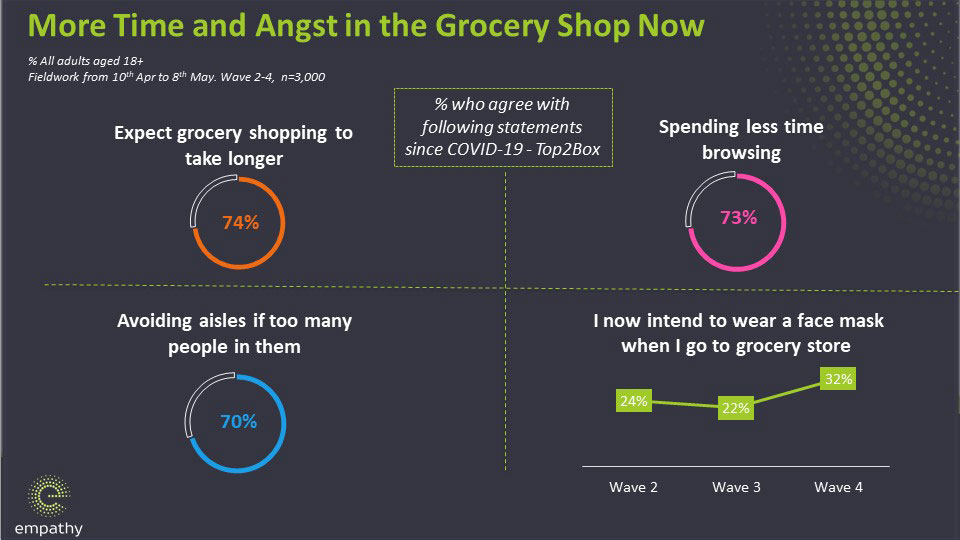The latest results from Empathy’s Covid-19 Tracking Research highlights the angst shoppers are experiencing when grocery shopping during COVID-19, writes Stephen Rust.
Anyone who has done any form of grocery shop in-store recently will have experienced the challenges that now come with trying to conduct their shop. It won’t come as a major surprise so that recent results from our Covid-19 tracker, which has surveyed over N=4,000 adults since restrictions were put in place some 8 weeks ago, show that shoppers are spending more time at the grocery store, but less time actually shopping since Covid-19.
What may come as a surprise though is how much angst this shopping experience is causing shoppers and how they are altering their in-store shopping behaviours to complete their shopping mission.
Pre Covid-19, the average time spent grocery shopping for the big weekly shop was circa 41-45 minutes. Our latest research shows that this time has increased, but this has not translated into more time actually shopping or browsing fixtures. There are 5 main reasons for this new in-store shopping behaviour:
- Firstly, the new social distancing measures of limiting the number of people in-store at any one time, keeping 2 meters apart, disinfecting the handles of trolleys, applying masks/gloves and more time queuing etc. is making the chore of shopping longer and more arduous.
- Secondly, shoppers are spending more time actively having to navigate the store to avoid other shoppers with 70% of adults avoiding a shopping aisle if too many people are in it since COVID-19.
- Thirdly, more people are returning to how they shopped 15-20 years ago where they will do one big weekly shop rather than 2-3 shorter top-up shops. This is down to the task of shopping becoming less convenient, plus people currently have more time in their week with less time working or commuting.
- Fourthly, people who do not usually do the big shop in the households have suddenly been tasked with this job now that they are available and at home. These shoppers tend not to be as familiar with efficiently navigating the store, and you can see them frantically looking at their list and going back and forth throughout the store.
Finally, for many shopping has become the only opportunity to socialise. So, when the neighbour or old friend is spotted in the aisle there is an inclination to stop at a safe distance and check-in on how all are managing through the crisis.
How will this behaviour impact retailers and manufacturers?
Herb Sorenson in his book ‘Inside the mind of the Shopper’ references that there are three factors that impact Shoppers decisions – that is Money, Time and Angst (i.e. effort of the shop). These new shopping behaviours identified in our research are going to impact all these factors, which in turn will change how retailers and manufacturers communicate, supply and merchandise their products in the future.
Previous research pre-Covid-19 found the average time shopping our usual food and drink categories can range from 2 seconds to over a minute depending on the category. For instance Milk is normally a quick product to buy with little thought needed at the fixture, versus categories like wine which is often a more considered shop with more time browsing different options so the average time at that fixture can be much longer.
With actual browsing time becoming squeezed for shoppers as they experience a more arduous and timely task of just getting to the fixture, retailers and manufacturers will have to work harder to stand out and minimise shopper’s proliferation of choice and succinctly communicate why their product range is good value for money. Since Covid-19 restrictions we have already seen evidence of a lot shoppers defaulting back to trusted and familiar brands (i.e. Kantar reported brand value growth post Covid-19 at +33%, which was 9% above market growth for same time period). In many categories this is because big familiar brands are an easier decision for shoppers during a longer more arduous shop with less time to browse.
In summary, the longer these restrictions are in place the more these shopping behaviours outlined will become habit and the smaller niche brands or new products will need to pro-actively defend their listings, and engage shoppers from consideration to the moment of choice. Parallel to that challenge, the more familiar and trusted brands will need to manage their physical availability to ensure that they are always at easy reach to shoppers and have enough shelf space to avoid running off sale.
The ‘new normal’ is still forming but understanding how to win with people along their path to purchase will be key to future growth.
Stephen Rust is Managing Director of Empathy Connects – Empathy’s Shopper Research Unit






















